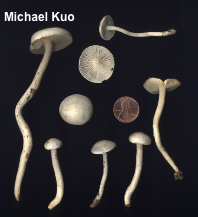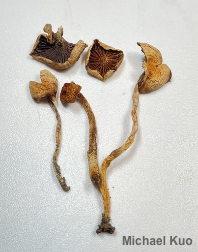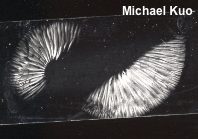| Major Groups > Gilled Mushrooms > Pale-Spored > Waxy Caps > Hygrophorus discoxanthus |

|
[ Basidiomycota > Agaricales > Hygrophoraceae > Hygrophorus . . . ] Hygrophorus discoxanthus by Michael Kuo, 28 November 2022 Distinguishing features for this waxy cap include its association with beech trees, its slender stature, and the mealy flakes near the apex of its stem. The gills are attached to the stem but do not run down it. Overall, the species is white when young and fresh, but it often develops yellow colors as it matures, and can even turn orangish brown. When dried for the herbarium, the gills of Hygrophorus discoxanthus turn dark reddish brown. Easy enough, right? Not if you turn to page 314 of Mushrooms of the Midwest, by some idiot named Michael Kuo (2014), where you will see the collection illustrated here, which I made in 2003, serving as an illustration for Hygrocybe virginea (now Cuphophyllus virgineus). For me this species is a lesson in hygrophoroid humility. I missed two crucial details: the flakes on the stem apex, and the non-decurrent gills—both of which should have led me away from Cuphophyllus virgineus. Additionally I had not done thorough microscopy with the collection, so I missed the divergent, rather than interwoven, gill trama. My bad. I will understand if you decide not to trust me about look-alike species: Hygrophorus chrysodon is also white-then-yellow, but its surfaces turn bright yellow to orange with KOH; Hygrophorus eburneus yellows only slightly, if at all; Hygrophorus piceae does not turn yellow and is associated with spruces. And there are a few others—but none of these species have gills that turn reddish brown when dried. Hygrophorus chrysaspis is a synonym. Description: Ecology: Mycorrhizal with American beech and with European beech; growing scattered or gregariously; summer and fall; originally described from Sweden (Fries 1815); widely distributed in Europe and North America within the natural range of the host trees. The illustrated and described collection is from Illinois. Cap: 1–4 cm across; convex when young, becoming broadly convex; sticky when fresh, but soon dry; bald; at first white, and sometimes remaining so for quite a while, but usually developing yellow shades and becoming yellow to orangish brown with old age. Gills: Broadly attached to the stem; nearly distant; whitish, becoming yellowish to yellow with age and, when dried, dark reddish brown; short-gills frequent. Stem: 4–12 cm long; 4–6 mm thick; equal above a tapered base; sticky when fresh but soon dry; with mealy flakes near the apex, but bald below; white, discoloring yellow like the cap. Flesh: White; unchanging when sliced. Odor and Taste: Not distinctive. Spore Print: White. Microscopic Features: Spores 6–9 x 3.5–5 µm; ellipsoid, with an apiculus; smooth; hyaline in KOH; inamyloid. Basidia 45–50 x 4–5 µm; subclavate; 4-sterigmate. Cystidia not found. Lamellar trama divergent. Pileipellis a trichoderm or ixotrichoderm; elements 2–4 µm wide, smooth, hyaline in KOH; clamp connections present. REFERENCES: (E. M. Fries, 1815) C. Rea, 1908. (Hesler & Smith, 1963; Smith, Smith & Weber, 1979; Arnolds, 1986; Breitenbach & Kränzlin, 1991; Candusso, 1997; Boertmann, 2000; Boertmann, 2010; Bessette et al., 2012; Buczacki et al., 2013; Lodge et al., 2013; Gminder & Böhning, 2017; Boertmann, 2018; Læssøe & Petersen, 2019; Kibby, 2020.) Herb. Kuo 09280303. This site contains no information about the edibility or toxicity of mushrooms. |
© MushroomExpert.Com |
|
Cite this page as: Kuo, M. (2022, November). Hygrophorus discoxanthus. Retrieved from the MushroomExpert.Com Web site: http://www.mushroomexpert.com/hygrophorus_discoxanthus.html |



